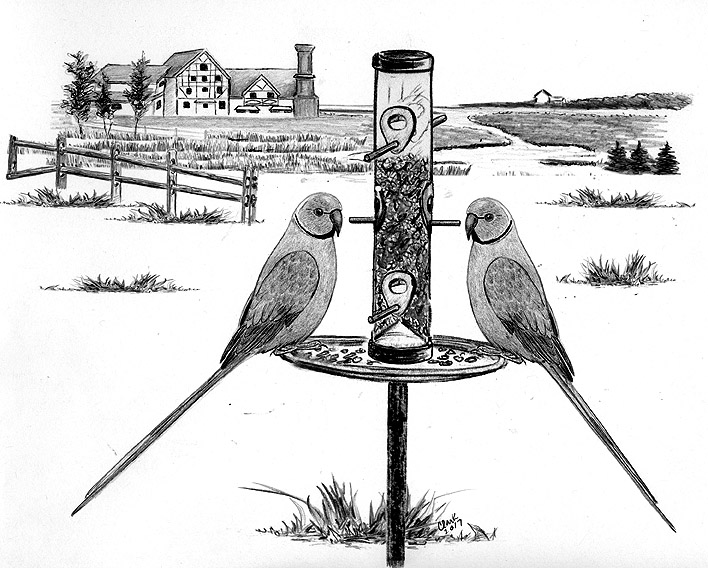
Dear Bird Folks,
A friend of mine sent me these photos from London, which I believe are of parakeets. The birds seem out of place, but London is a big polyglot city. Are they native?
– George, Arlington, VA
Take it easy, George,
Try to remember to whom you are talking. I’m just a simple Cape Cod shopkeeper. You can’t use such fancy city words in your question and expect me to know what you are talking about. “Polyglot”? Is that a baby frog or something? Also, where is this “London” of which you speak? It must be off-Cape someplace.
The birds in your friend’s photos are indeed parakeets, Rose-ringed Parakeets to be exact. Rose-ringed Parakeets are striking, brilliant birds with a red parrot-style beak and red and yellow psycho-looking eyes. The male Rose-ringed Parakeet has the signature rose (and black) neck ring, which is lacking on the young birds and females. And as you suspected, Rose-ringed Parakeets don’t belong in London, or anywhere else in England. They are normally found in central Africa, India and southern Asia. How these tropical birds ended up on the streets of London is a mystery…a mystery with a lot of theories, and here they are.
Some folks blame the darn Nazis for the birds’ arrival, as it is thought a number of them escaped from the London Zoo when it was bombed during the war. Other folks think the birds snuck away from the set of the 1951 movie, The African Queen, while it was being filmed in nearby Isleworth Studios. My favorite theory has to do with the late Jimi Hendrix, who was said to have released a pair of Rose-ringed Parakeets when he lived on Carnaby Street in the late ‘60s. Jimi’s girlfriend (of the time) disputes this theory, saying that she doesn’t remember Jimi ever having pet birds. But in reality, I’m sure there is a lot from back then she doesn’t remember.
While the Hendrix notion is charming and I’d like to blame anything I possibly can on the Nazis, the truth is no one knows for sure how these big green birds arrived in London. Due to their adaptability and their attractive coloring, Rose-ringed Parakeets are a common choice for people who like to keep birds in cages. It is quite likely that London’s parakeets are merely pets that have escaped confinement, or were purposely released into the wild when a family member couldn’t stand the squawking anymore.
Whatever their back-story is, Rose-ringed Parakeets are now common birds throughout London and many Brits aren’t happy about it. Londoners say the birds, while pretty, are noisy and regularly bully smaller birds away from their feeders. In addition, the parakeets are cavity nesters, which means they aggressively compete with native British birds for nesting holes. Ironically, the Brits are now complaining about a bird that is doing the exact same thing their exported English (House) Sparrow has been doing to our birds for over a century. Karma strikes again. Introducing any foreign species is rarely a good thing, but when you think about it, having a flashy parakeet around may not be so bad. Between the dank weather and their cuisine (mushy peas) the Brits could use a little color in their lives, right? What’s wrong with having a few wild parakeets around? Well, perhaps a “few” parakeets would be fine, but as their population continues to grow, the birds are spreading from parks and backyards to the fields, where they are now causing havoc with the local farmers and that’s not good. The last thing the British farmers need is to have some imported bird interfere with their crops…especially the mushy peas.
If you would like to see a Rose-ringed Parakeet in person, George, you don’t have to travel to England. These adaptable birds are now found in over thirty-five countries outside of their normal range. Paris, Rome, Tokyo and Los Angeles (and other polyglot cities) now have a population of Rose-ringed Parakeets. Once again, the culprit for this massive expansion very likely stems from escapees caused by the dreaded caged bird industry. Either that or Jimi Hendrix did far more traveling than any of us ever thought.
On a different topic:
My hometown of Orleans has never had much in the way of notoriety. A German sub once bombed Nauset Beach and a group of psychotic state officials gave us the world’s scariest traffic rotary, and that’s about it. We did, however, have a major local celebrity. It was Robert, a little orphaned bobwhite that was raised by the Kienzle family and immortalized in Margaret Stanger’s book, That Quail, Robert. While I never met Robert, or the Kienzles or Miss. Stanger, the book’s illustrator was a regular patron of my shop. Orleans’ very own Cathy Baldwin was a young RISD student when she was asked to supply black and white drawings to augment Stanger’s book. In her later years, Ms. Baldwin continued to graciously answer questions about Robert and was even patient with a very nosy bird storeowner. This is why I’m particularly sad to report that our little town has lost an artist, a nature lover and an important contributor to one of the most charming bird books ever written. Thanks for a job well done, Cathy. I don’t think any of your fans will ever hear a bobwhite call again without thinking of you…and smiling.